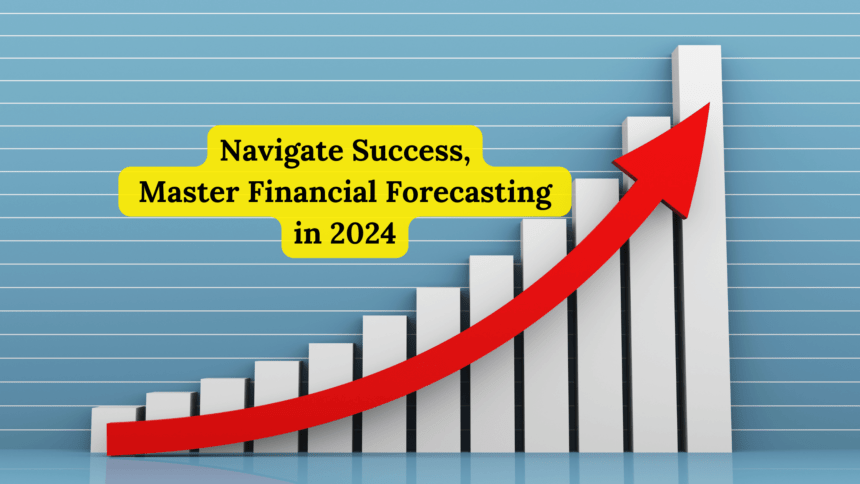Introduction
In the volatile economic landscape of 2024, mastering financial forecasting has become imperative. Master Financial Forecasting isn’t just about predicting future revenues or expenses; it’s a strategic tool that can determine the success or failure of a business. From small enterprises to multinational corporations, accurate financial forecasting allows businesses to navigate uncertainty with confidence.
The Importance of Financial Forecasting in 2024
The importance of financial forecasting in 2024 cannot be overstated. Businesses are operating in an increasingly complex environment characterized by rapid technological advancements, global supply chain disruptions, and shifting consumer behaviors. In such a milieu, financial forecasting provides the clarity needed to make informed decisions, allocate resources effectively, and anticipate potential financial hurdles.
Evolution of Financial Forecasting: A Historical Perspective
Financial forecasting has evolved significantly over the decades. In the early 20th century, forecasting relied heavily on manual calculations and rudimentary statistical methods. The advent of computers in the mid-20th century revolutionized forecasting techniques, enabling more sophisticated analyses. Today, with the integration of artificial intelligence and big data, financial forecasting has reached unprecedented levels of accuracy and efficiency.
Understanding Financial Forecasting
Financial forecasting involves the use of historical data and statistical models to predict future financial performance. It encompasses a range of activities, from estimating future revenues and expenses to predicting cash flows and financial outcomes. Understanding the key concepts and methodologies is essential for effective forecasting.
Definition and Key Concepts
At its core, financial forecasting is the process of estimating future financial outcomes based on historical data, current market trends, and economic indicators. Key concepts include revenue forecasting, expense forecasting, cash flow analysis, and financial modeling.
Types of Financial Forecasts: Short-Term vs. Long-Term
Financial forecasts can be broadly categorized into short-term and long-term forecasts. Short-term forecasts typically cover a period of up to one year and focus on immediate financial needs and goals. Long-term forecasts, on the other hand, extend beyond one year and are used for strategic planning and investment decisions.
The Role of Technology in Financial Forecasting
Technology plays a pivotal role in modern financial forecasting. Advanced technologies such as artificial intelligence, machine learning, big data analytics, and cloud computing have transformed how businesses approach forecasting, making it more accurate and efficient.
Artificial Intelligence and Machine Learning
Artificial intelligence (AI) and machine learning (ML) are revolutionizing financial forecasting. These technologies enable the analysis of vast amounts of data, identifying patterns and trends that would be impossible for humans to detect. AI and ML can enhance the accuracy of forecasts by continuously learning from new data and refining their predictions.
Big Data Analytics
Big data analytics involves the examination of large data sets to uncover hidden patterns, correlations, and insights. In financial forecasting, big data analytics allows businesses to incorporate a wider range of variables and data sources, leading to more comprehensive and accurate forecasts.
Cloud Computing Solutions
Cloud computing provides the infrastructure needed to store, process, and analyze large volumes of data. By leveraging cloud-based solutions, businesses can access powerful forecasting tools and collaborate in real-time, improving the efficiency and accuracy of their forecasting processes.
Essential Financial Forecasting Techniques
Various techniques are used in financial forecasting, each with its strengths and applications. Understanding these techniques is crucial for selecting the most appropriate method for your business.
Quantitative Methods
Quantitative methods involve the use of numerical data and statistical models to generate forecasts. Common quantitative techniques include time series analysis, regression analysis, and econometric modeling.
Qualitative Methods
Qualitative methods rely on expert opinions, market research, and subjective judgment to generate forecasts. Techniques such as Delphi method, market research, and expert panels are commonly used in qualitative forecasting.
Scenario Analysis
Scenario analysis involves creating multiple forecasts based on different assumptions and potential future events. This technique helps businesses prepare for various outcomes and develop contingency plans.
Building a Robust Financial Forecasting Model
Creating an accurate and reliable financial forecasting model requires careful planning and execution. Key steps include gathering accurate data, choosing the right forecasting model, and testing and validating the model.
Gathering Accurate Data
Accurate data is the foundation of any reliable financial forecast. This involves collecting historical financial data, market trends, economic indicators, and other relevant information. Ensuring data quality and consistency is paramount.
Choosing the Right Forecasting Model
Selecting the appropriate forecasting model depends on the nature of the business, the availability of data, and the specific forecasting goals. Common models include linear regression, moving averages, and ARIMA models.
Testing and Validating the Model
Once a forecasting model is developed, it must be rigorously tested and validated. This involves comparing the model’s predictions with actual outcomes and making necessary adjustments to improve accuracy.
Key Metrics and Indicators in Financial Forecasting
Certain metrics and indicators are essential for effective financial forecasting. These include revenue projections, expense forecasting, and cash flow analysis.
Revenue Projections
Revenue projections estimate future sales and income based on historical data, market trends, and economic conditions. Accurate revenue projections are crucial for budgeting and strategic planning.
Expense Forecasting
Expense forecasting involves predicting future costs, including operating expenses, capital expenditures, and other financial obligations. This helps businesses manage their budgets and control costs.
Cash Flow Analysis
Cash flow analysis examines the inflows and outflows of cash to ensure a business has sufficient liquidity to meet its obligations. It is a critical component of financial forecasting and financial health assessment.
The Human Element in Financial Forecasting
Despite the advancements in technology, the human element remains crucial in financial forecasting. Experience, intuition, and collaboration play significant roles in the forecasting process.
The Role of Experience and Intuition
Experienced financial analysts bring valuable insights and intuition to the forecasting process. Their ability to interpret data, recognize trends, and anticipate market shifts is invaluable.
Cross-Functional Collaboration
Effective financial forecasting requires collaboration across various functions, including finance, marketing, operations, and sales. This ensures that forecasts are comprehensive and account for all aspects of the business.
Common Challenges in Financial Forecasting
Financial forecasting is fraught with challenges, including data quality issues, market volatility, and the difficulty of predicting rare, high-impact events.
Data Quality Issues
Poor data quality can significantly undermine the accuracy of financial forecasts. Ensuring data integrity, consistency, and completeness is essential for reliable forecasting.
Market Volatility
Market volatility and economic uncertainty can make financial forecasting challenging. Businesses must account for these factors and incorporate flexibility into their forecasting models.
Predicting Black Swan Events
Black swan events are rare and unpredictable occurrences with significant impact. While they are difficult to forecast, businesses can develop contingency plans and stress-test their forecasts to prepare for such events.
Strategies for Improving Forecast Accuracy
Various strategies can enhance the accuracy of financial forecasts, including improving data collection processes, utilizing advanced analytics, and continuously monitoring and adjusting forecasts.
Enhancing Data Collection Processes
Improving the processes for collecting and managing data can significantly enhance forecast accuracy. This includes implementing robust data governance practices and leveraging technology to automate data collection.
Utilizing Advanced Analytics
Advanced analytics tools, such as predictive modeling and machine learning algorithms, can provide deeper insights into financial data. These tools analyze complex data sets and identify patterns that traditional forecasting methods may overlook. By incorporating advanced analytics into the forecasting process, businesses can improve the accuracy of their predictions and make more informed decisions.
Continuous Monitoring and Adjustment
Financial forecasting is not a one-time exercise but a continuous process. Businesses should regularly monitor actual performance against forecasted outcomes and make adjustments as needed. This iterative approach ensures that forecasts remain relevant and responsive to changing market conditions.
Financial Forecasting for Different Industries
Financial forecasting varies across industries due to unique market dynamics, regulatory environments, and operational challenges.
Retail
In the retail sector, forecasting focuses on predicting consumer demand, optimizing inventory levels, and managing seasonal fluctuations. Advanced analytics and point-of-sale data analysis are critical for accurate forecasting.
Manufacturing
Manufacturing firms use forecasting to plan production schedules, manage supply chains, and optimize resource allocation. Techniques like demand forecasting and capacity planning are essential for operational efficiency.
Technology
Technology companies rely on forecasting to plan product development cycles, allocate R&D investments, and forecast revenue streams from software licenses and subscriptions.
Healthcare
In the healthcare industry, forecasting is used to predict patient volumes, plan staffing levels, and manage healthcare expenditures. Factors such as regulatory changes and demographic trends influence healthcare forecasting.
Regulatory and Compliance Considerations
Compliance with regulatory requirements is crucial in financial forecasting, especially in highly regulated industries such as finance, healthcare, and pharmaceuticals.
Understanding Regulatory Requirements
Financial forecasters must stay abreast of regulatory changes that impact financial reporting and forecasting practices. Compliance with standards such as GAAP (Generally Accepted Accounting Principles) ensures the accuracy and transparency of financial forecasts.
Ensuring Data Security and Privacy
Protecting sensitive financial data is paramount in financial forecasting. Businesses must implement robust data security measures and adhere to data privacy regulations to safeguard confidential information.
Case Studies in Successful Financial Forecasting
Examining real-world examples of successful financial forecasting can provide valuable insights into best practices and strategies.
Case Study 1: A Retail Giant’s Forecasting Triumph
This case study explores how a leading retail company used advanced analytics and predictive modeling to forecast consumer demand accurately. By analyzing historical sales data and market trends, the company optimized inventory management and enhanced profitability.
Case Study 2: Manufacturing Firm’s Predictive Accuracy
In this case study, a manufacturing firm leveraged scenario analysis and demand forecasting techniques to anticipate shifts in market demand and adjust production levels accordingly. The firm’s proactive approach to forecasting contributed to improved operational efficiency and customer satisfaction.
Tools and Software for Financial Forecasting
An overview of leading forecasting tools and software solutions available to businesses can streamline the forecasting process and enhance accuracy.
Overview of Leading Forecasting Tools
Leading forecasting tools, such as Oracle Hyperion, SAP Business Planning and Consolidation (BPC), and IBM Planning Analytics, offer advanced capabilities for financial modeling, scenario planning, and predictive analytics.
Integrating Software Solutions into Business Operations
Integrating forecasting software into business operations requires careful planning and implementation. Businesses should consider factors such as scalability, user-friendliness, and compatibility with existing systems when selecting a forecasting solution.
The Future of Financial Forecasting
Looking ahead, financial forecasting is poised to evolve further in response to technological advancements, globalization, and shifting consumer preferences.
Emerging Trends
Emerging trends in financial forecasting include the adoption of AI-driven forecasting models, the integration of real-time data analytics, and the rise of predictive analytics platforms. These trends promise to enhance forecast accuracy and enable businesses to make data-driven decisions swiftly.
The Impact of Globalization
Globalization has transformed the business landscape, influencing financial forecasting by expanding market opportunities, increasing competition, and introducing new risk factors. Businesses must adapt their forecasting strategies to navigate global economic trends effectively.
The Role of Sustainability
Sustainability considerations are becoming integral to financial forecasting as businesses prioritize environmental, social, and governance (ESG) factors. Forecasting models that incorporate sustainability metrics enable businesses to assess the long-term impact of their operations and investments.
Practical Steps to Implement Financial Forecasting in Your Business
Implementing financial forecasting requires a structured approach and commitment to best practices.
Initial Assessment and Goal Setting
Begin by assessing your organization’s current forecasting capabilities and defining clear objectives for implementing or improving financial forecasting practices. Establish measurable goals and timelines for implementation.
Developing a Forecasting Team
Assemble a multidisciplinary team comprising finance professionals, data analysts, and subject matter experts. Foster collaboration and knowledge sharing to leverage diverse perspectives in forecasting activities.
Implementing the Forecasting Process
Implement a systematic approach to financial forecasting that includes data collection, model development, validation, and reporting. Use feedback loops to refine forecasting models and enhance accuracy over time.
Training and Development for Financial Forecasting
Investing in training and development programs ensures that your forecasting team possesses the necessary skills and expertise to perform accurate and insightful financial analysis.
Essential Skills for Forecasters
Key skills for financial forecasters include proficiency in statistical analysis, data visualization, software proficiency (e.g., Excel, statistical software), and critical thinking. Continuous learning and staying updated on industry trends are also essential.
Available Training Programs and Certifications
Explore training programs and certifications offered by professional organizations, universities, and online platforms. Certifications such as Certified Financial Forecaster (CFF) demonstrate proficiency and enhance credibility in financial forecasting.
Financial Forecasting in a Post-Pandemic World
The COVID-19 pandemic has reshaped the business landscape and underscored the importance of agile forecasting capabilities.
Adapting to New Market Realities
Businesses must adapt their forecasting strategies to address evolving consumer behavior, supply chain disruptions, and economic recovery efforts post-pandemic. Flexibility and scenario planning are critical in navigating uncertainties.
The Shift to Digital Transformation
The accelerated pace of digital transformation has accelerated the adoption of digital tools and technologies in financial forecasting. Cloud-based solutions, AI-driven analytics, and remote collaboration tools are reshaping forecasting practices.
The Impact of Financial Forecasting on Strategic Planning
Financial forecasting plays a pivotal role in strategic planning by informing resource allocation, investment decisions, and long-term growth strategies.
Aligning Forecasts with Business Strategy
Integrate financial forecasts with strategic goals and objectives to ensure alignment across departments and stakeholders. Use forecasts to identify opportunities for growth, mitigate risks, and optimize resource allocation.
Enhancing Decision-Making Processes
Data-driven forecasts provide decision-makers with actionable insights and informed recommendations. By incorporating financial forecasts into decision-making processes, businesses can achieve greater agility and competitive advantage.
Maintaining Flexibility in Financial Forecasting
Flexibility is crucial in financial forecasting to adapt to changing market conditions, unexpected events, and emerging opportunities.
The Importance of Agile Forecasting
Adopt agile forecasting practices that emphasize responsiveness, iterative adjustments, and continuous improvement. Agile forecasting enables businesses to quickly pivot strategies and capitalize on emerging trends or mitigate risks.
Techniques for Rapid Adjustments
Implement techniques such as rolling forecasts, sensitivity analysis, and real-time data monitoring to facilitate rapid adjustments to forecasts. Proactively identify and address deviations from projected outcomes to maintain forecast accuracy.
Conclusion
In conclusion, mastering financial forecasting in 2024 requires a strategic approach, advanced analytical tools, and a commitment to continuous improvement. By harnessing the power of technology, integrating sustainability considerations, and fostering collaboration across functions, businesses can navigate uncertainty with confidence and achieve sustainable growth.
For more content follow Humstory.













